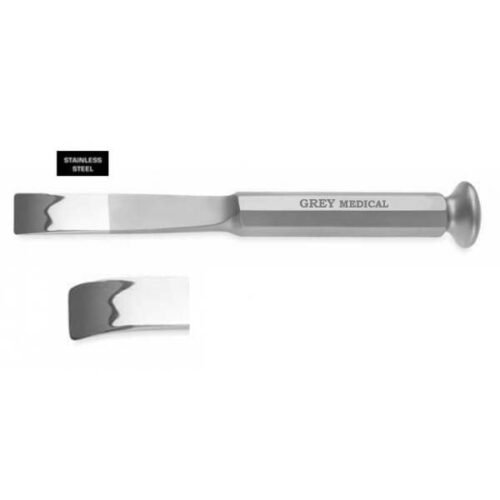Osteotome: A Key Instrument in Bone Surgery
Osteotome: A Key Instrument in Bone Surgery
Blog Article
An osteotome is a specialized surgical instrument used to cut or shape bone during medical procedures. The name "osteotome" is derived from the Greek words "osteon" (bone) and "temnein" (to cut), reflecting its primary function in orthopedic, maxillofacial, and reconstructive surgeries. It resembles a chisel, with a sharp, beveled edge designed for precise bone manipulation, and is commonly used in conjunction with a mallet to facilitate controlled cuts.

Design and Features
Osteotomes are typically crafted from high-quality stainless steel or titanium to ensure durability, sharpness, and resistance to corrosion. They come in a variety of sizes and blade configurations to accommodate different surgical needs. Key design features of an osteotome include:
- Blade: The cutting edge can be straight, curved, or angled, depending on the specific application. The blade is extremely sharp, enabling clean and precise cuts.
- Handle: The handle is ergonomically designed to provide a comfortable and secure grip for the surgeon. Some osteotomes have textured handles to prevent slipping during use.
- Bevels: Osteotomes can be single-beveled or double-beveled. Single-beveled osteotomes are ideal for making directional cuts, while double-beveled ones are used for symmetrical cuts.
Modern osteotomes may also feature detachable blades or come as part of modular systems, allowing for customization based on the procedure.
Applications in Surgery
Osteotomes are versatile tools used in a wide range of surgical specialties. Their primary function is to cut, shape, or remove bone tissue while preserving surrounding structures. Common applications include:
- Orthopedic Surgery:
- Used to perform precise cuts in bone during procedures like joint replacement, fracture repair, or corrective surgeries.
- Essential in shaping bone grafts to fit specific defects or implants.
- Craniofacial and Maxillofacial Surgery:
- In reconstructive surgeries, osteotomes help reshape facial bones to restore function or aesthetics.
- Used in procedures such as Le Fort osteotomies for correcting midface deformities.
- Dental and Oral Surgery:
- Osteotomes are used in implantology to prepare bone sites for dental implants or to perform sinus lifts.
- Used for splitting or condensing bone in alveolar ridge augmentation.
- Neurosurgery:
- In spinal surgeries, osteotomes assist in cutting bone to relieve pressure on nerves or correct deformities.
- Plastic Surgery:
- In rhinoplasty (nasal surgery), osteotomes are used to precisely alter the nasal bone structure to achieve the desired aesthetic outcome.
Advantages
The osteotome offers several benefits in surgical applications:
- Precision: Its sharp blade ensures clean, controlled cuts, reducing the risk of unintended damage to surrounding tissues.
- Versatility: Available in various shapes and sizes, it adapts to diverse surgical needs.
- Durability: Made from premium materials, osteotomes withstand rigorous use and repeated sterilization.
- Cost-Effectiveness: Osteotomes are reusable instruments, making them a cost-effective solution in surgical settings.
Care and Maintenance
Proper care and maintenance are critical to preserving the functionality and longevity of an osteotome. After each use, the instrument should be thoroughly cleaned to remove blood, bone fragments, and other debris. Sterilization using an autoclave or other approved methods ensures it remains safe for use in future procedures. Regular inspection for signs of wear, dullness, or damage is essential, as a dull or damaged osteotome can compromise surgical outcomes. If necessary, the blade can be resharpened or replaced.
Conclusion
The osteotome is a vital tool in modern surgical practice, offering precision and versatility in bone manipulation. From orthopedic and dental surgeries to craniofacial and reconstructive procedures, it plays a crucial role in achieving optimal patient outcomes. With proper care and skilled use, the osteotome continues to be a cornerstone instrument in the surgical toolkit, aiding surgeons in shaping and transforming bone to restore health and functionality. Report this page